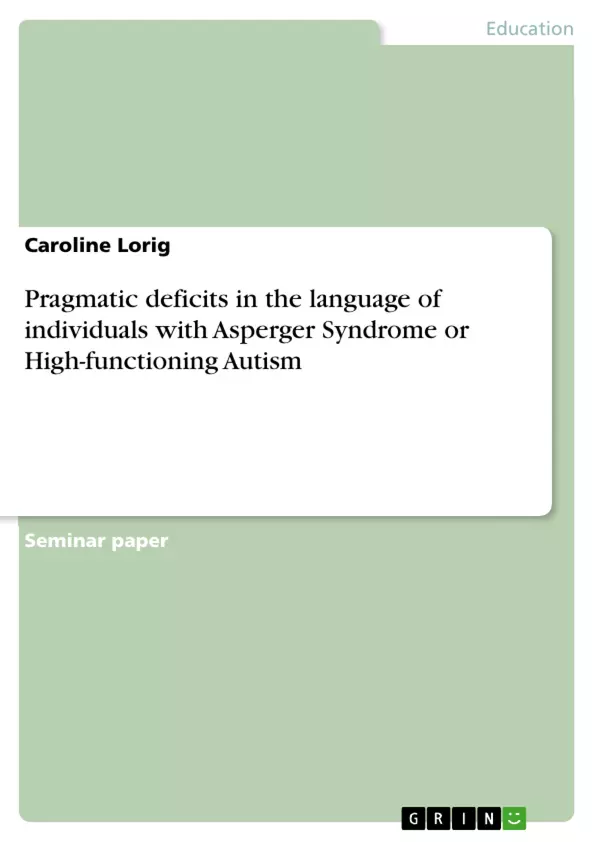“Not everything that steps out of line, and thus ‘abnormal’, must necessarily be ‘inferior’” Hans Asperger (1938)
Luisa is fifteen years old and a very pretty young girl. In school life, she takes the role of the friendly, shy and overly calm girl who especially flourishes when reciting verses by heart or when singing songs. In other situations, she stays very calm and sometimes even seems to be withdrawn from what is happening around her. If you spend more time together with her, you will notice how much she tries to be integrated in the social life around her, but also how she does not know how to go about it. When you talk to her, she rarely looks at her conversation partner and she often seems to answer inadequately to specific questions. Nevertheless, her vocabulary is very felicitous, although sometimes you feel like she actually does not want to listen to what you yourself have to tell.
Luisa is diagnosed with high-functioning autism. A lack of social understanding, a limited ability in conducting a reciprocal conversation and a repetitive repertoire of interests are the main symptoms of high-functioning autism. I work with Luisa and many times, I had to experience a hindered communication due to her problems of understanding the meaning of what other people say, or how to use speech appropriately herself. This is why I chose this topic.
The first part of this paper deals with the attempt to find a definition for Autism, Asperger Syndrome and High-functioning Autism. A general overview of the typical symptoms, diagnosis criteria and especially the difficulties in the prag-matic aspects of language shall be given. In the second part, the theoretical framework of this paper shall be explained. Relevance Theory and the Theory of Mind will be explained in more detail as they both might be able to explain at least some features of the language of individuals with Asperger syndrome and high-functioning autism. The main part of this paper, however, is concerned with the pragmatic deficits in the language of people with Asperger syndrome and high-functioning autism, exemplified and explained in more detail by means of several sample utterances.
Inhaltsverzeichnis (Table of Contents)
- 1. Introduction
- 2. What is Autism? A short outline
- 2.1 Asperger syndrome (AS)
- 2.2 High-functioning Autism (HFA)
- 3. The theoretical framework of this paper: Pragmatics
- 3.1 Relevance Theory
- 3.2 Theory of Mind
- 4. Pragmatic deficits in the language of individuals with Asperger syndrome and High-functioning Autism
- 4.1 Pragmatic deficits of individuals with AS and HFA due to lack of relevance
- 4.2 Pragmatic deficits of individuals with AS and HFA due to difficulties in their mind-reading ability.
- 5. Conclusion
Zielsetzung und Themenschwerpunkte (Objectives and Key Themes)
This paper aims to explore the pragmatic deficits in the language of individuals with Asperger Syndrome and High-functioning Autism. The paper begins by providing a definition and outlining the typical symptoms, diagnosis criteria, and language-related difficulties associated with these conditions. It then delves into the theoretical framework of pragmatics, specifically examining Relevance Theory and the Theory of Mind, to understand how these theories can explain the language use of individuals with AS and HFA. The main focus of the paper lies in analyzing and illustrating pragmatic deficits through various examples of language use.
- Defining and outlining the characteristics of Autism, Asperger Syndrome, and High-functioning Autism
- Examining the role of Relevance Theory and the Theory of Mind in understanding the language of individuals with AS and HFA
- Analyzing pragmatic deficits in the language of individuals with AS and HFA, particularly in relation to relevance and mind-reading abilities
- Providing examples of language use to illustrate these pragmatic deficits
Zusammenfassung der Kapitel (Chapter Summaries)
- Chapter 1: Introduction The introduction introduces the paper's topic, pragmatic deficits in the language of individuals with Asperger Syndrome and High-functioning Autism. It uses the case of Luisa, a fifteen-year-old girl diagnosed with high-functioning autism, to illustrate the challenges she faces in social interaction and communication. The chapter outlines the paper's structure, highlighting the key aspects that will be covered.
- Chapter 2: What is Autism? A short outline This chapter defines autism and provides a brief overview of Asperger syndrome (AS) and High-functioning Autism (HFA). It delves into the history of autism research and its diagnosis criteria, highlighting the significant diversity of symptoms and manifestations of autism spectrum disorders. The chapter concludes by outlining the specific language-related impairments commonly observed in individuals with autism.
- Chapter 3: The theoretical framework of this paper: Pragmatics This chapter focuses on the theoretical framework of pragmatics, exploring two central theories: Relevance Theory and the Theory of Mind. It discusses how these theories can potentially explain the language difficulties experienced by individuals with AS and HFA.
- Chapter 4: Pragmatic deficits in the language of individuals with Asperger syndrome and High-functioning Autism This chapter delves into the core issue of pragmatic deficits in the language of individuals with AS and HFA. It explores these deficits in relation to both a lack of relevance and difficulties in mind-reading ability. The chapter analyzes various language examples to illustrate these pragmatic challenges.
Schlüsselwörter (Keywords)
The primary keywords and focus topics of this paper include autism, Asperger syndrome, high-functioning autism, pragmatics, Relevance Theory, Theory of Mind, pragmatic deficits, social communication, language impairments, mind-reading, relevance, and language use.
- Quote paper
- Caroline Lorig (Author), 2010, Pragmatic deficits in the language of individuals with Asperger Syndrome or High-functioning Autism , Munich, GRIN Verlag, https://www.grin.com/document/169703



